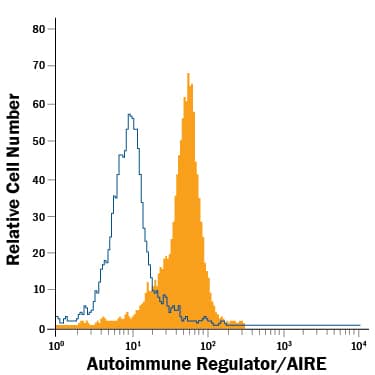Mouse Autoimmune Regulator/AIRE Alexa Fluor® 488-conjugated Antibody
R&D Systems, part of Bio-Techne | Catalog # IC6184G


Key Product Details
Species Reactivity
Applications
Label
Antibody Source
Product Specifications
Immunogen
Ser476-Ser552 (predicted)
Accession # Q9Z0E3
Specificity
Clonality
Host
Isotype
Scientific Data Images
Detection of Autoimmune Regulator/AIRE in Mouse Splenocytes by Flow Cytometry.
Mouse splenocytes were stained with Rat Anti-Mouse Autoimmune Regulator/AIRE Alexa Fluor® 488-conjugated Monoclonal Antibody (Catalog # IC6184G, filled histogram) or isotype control antibody (Catalog # IC006G, open histogram). View our protocol for Staining Intracellular Molecules.Applications
Intracellular Staining by Flow Cytometry
Sample: Mouse splenocytes fixed with Flow Cytometry Fixation Buffer (Catalog # FC004) and permeabilized with Flow Cytometry Permeabilization/Wash Buffer I (Catalog # FC005)
Formulation, Preparation, and Storage
Purification
Formulation
Shipping
Stability & Storage
- 12 months from date of receipt, 2 to 8 °C as supplied.
Background: Autoimmune Regulator/AIRE
Autoimmune Regulator (AIRE) is an approximately 60 kDa nuclear and cytosolic protein that is required for the development of T cell tolerance. It regulates the expression of self-antigens by both thymic epithelial cells and extrathymic cell types. Genes known to be regulated by AIRE include FABP2, Proinsulin, Oxytocin, MCP-2, S100A8 and Cytochrome p450. The genes, referred to as TRAs, represent non-thymic, tissue-specific molecules that could serve as autoantigens at a later date. Their expression in the thymus (and select extrthymic sites) allows for the indentification and elimination of potentially autoreactive T cell clones. While some mouse and human molecules are identical in their regulation by AIRE, possibly not all are, and this leads to subtle differences in the autoimmune syndromes seen in human and mouse that are attributable to AIRE absence or mutation. AIRE regulates gene transcription through interactions with DNA, histone H3, and the nuclear matrix. It contains one HSR domain that is involved in dimerization (aa 1-106), a nuclear localization sequence (aa 114-134), one SAND domain involved in DNA binding (aa 182-282), and two PHD zinc finger domains that mediate protein-protein interactions (aa 298-345 and aa 433-475). Alternate splicing of mouse AIRE generates at least eleven isoforms. Within aa 476-552, mouse AIRE shares 91% and 64% aa sequence identity with rat and human AIRE, respectively.
Alternate Names
Gene Symbol
UniProt
Additional Autoimmune Regulator/AIRE Products
Product Specific Notices
This product is provided under an agreement between Life Technologies Corporation and R&D Systems, Inc, and the manufacture, use, sale or import of this product is subject to one or more US patents and corresponding non-US equivalents, owned by Life Technologies Corporation and its affiliates. The purchase of this product conveys to the buyer the non-transferable right to use the purchased amount of the product and components of the product only in research conducted by the buyer (whether the buyer is an academic or for-profit entity). The sale of this product is expressly conditioned on the buyer not using the product or its components (1) in manufacturing; (2) to provide a service, information, or data to an unaffiliated third party for payment; (3) for therapeutic, diagnostic or prophylactic purposes; (4) to resell, sell, or otherwise transfer this product or its components to any third party, or for any other commercial purpose. Life Technologies Corporation will not assert a claim against the buyer of the infringement of the above patents based on the manufacture, use or sale of a commercial product developed in research by the buyer in which this product or its components was employed, provided that neither this product nor any of its components was used in the manufacture of such product. For information on purchasing a license to this product for purposes other than research, contact Life Technologies Corporation, Cell Analysis Business Unit, Business Development, 29851 Willow Creek Road, Eugene, OR 97402, Tel: (541) 465-8300. Fax: (541) 335-0354.
For research use only